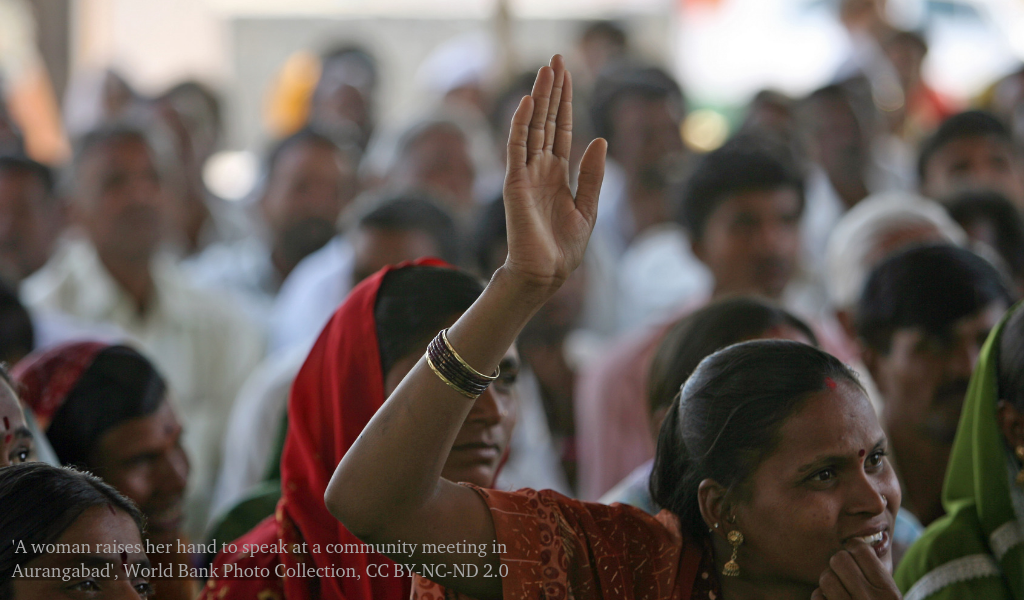Community engagement has the potential to put people, their perceptions and priorities at the heart of both social and biological science development research.

‘A woman raises her hand to speak at a community meeting in Aurangabad’, Flickr.com, World Bank Photo Collection, CC BY-NC-ND 2.0
I recently took part in a workshop about community engagement to tackle antimicrobial resistance. The workshop was organised by Changing the Story, a group of interdisciplinary researchers at the University of Leeds who are asking how the arts, heritage, and human rights education can support youth-centred approaches to civil society building in post-conflict settings across the world. Community engagement is something we focus on a lot at IDS, using bottom-up approaches to make voices of the voiceless heard: by policymakers, government officials and those who are considered powerful.
During the three-day workshop on the slopes of a beautiful mountain of Nepal we shared our experiences and insights from our work involving community engagement in different countries in tackling antimicrobial resistance (AMR). I learned a lot in these three days. In particular, a few themes resonated with my work related to One Health and AMR, which I’d like to elaborate here.
Identifying community leaders
First, the group discussed in length the dangers of community engagement. Often, the funding environment and project logistics do not allow enough time to investigate the power dynamics within a ‘community’. As a result, we – researchers and outsiders – end up working with the obvious leaders of a community.
In relatively homogeneous communities, this approach may indeed help represent the voices of the community. But often, communities are heterogeneous. For instance, views of women in a community may vastly differ from those of men.
Beyond gender, many things divide a community: religion, social class, ethnicity and disability are just the tip of the iceberg. By working with easily accessible community members, are we, outsiders, possibly worsening already-sensitive power dynamics within a community?
Taking evaluation seriously
Second, we talked about the impact of community engagement. Can we measure and communicate this impact adequately?
Often, the path of community engagement is dynamic and complex. How researchers design interventions (i.e. engagement) in relation to their outcomes is most certainly not how the reality will develop. This is its very beauty, but also the challenge of evaluating its impact.
I am only familiar with quantitative ways of evaluating a project’s impact. In economics and many public health-related fields (e.g. human medicine and veterinary science), what we look for is a clean, well-defined treatment group and control group, with well-defined sets of interventions and outcome variables.
Evaluating community engagement effort does not fit this neat picture at all.
Yet qualitative evidence is often framed as ‘soft’ and not taken seriously by policymakers. How can we change this dynamic?
Sustainability and scalability
Third, what is the sustainability and scalability of community engagement approaches? Colleagues from Nepal and other countries were convinced that community engagement works. But, as I learned at the workshop, none of us could concretely say that community engagement has a lasting impact in the communities where we worked or how this can be scaled up.
The very definition of community engagement is that local people are in charge of their own lives and wellbeing. What people want will differ across countries, communities and generations. This implies that, when issues such as AMR may not be a priority for community members, community-based bottom-up approaches will, understandably, not focus on these issues after research projects finish.
Also, presentations throughout the three days showcased innovative and interesting methods of community engagement. But several speakers pointed out how the same method was applied differently in different contexts or the scalability had not yet been tested yet.
In the Global Challenges Research Fund (GCRF) One Health Poultry Hub, we have set global public health challenges at the heart of our research and impact strategies. Our focus is on poultry-related health hazards, including food-borne zoonotic pathogens, avian influenza and AMR.
As countries grow richer and become more urbanised, demand for chicken meat and eggs is increasing. Meeting the demand will require everyone involved – producers and business people, policymakers and researchers – to work toward safe, ample and profitable supply of chicken meat and eggs. This will need not only changes in policies but also community-led approaches to coming up with solutions.
Understanding disease differently
My experience with working with ‘the community’ is limited. But through the Myanmar Pig Partnership, I have come to understand the challenges of community-based approach for endemic zoonoses. The health hazards of endemic zoonoses are estimated to be high particularly among poor people in low- and middle-income countries. But in reality, the burdens of endemic zoonoses are not well understood.
Farmers and local people do not have access to laboratory-based diagnosis, which makes it difficult for them to attribute the health conditions they are suffering from (e.g. diarrhoea) to invisible organisms. As a result, when we talked to farmers about animal diseases, their main concerns were the impact of these diseases on their businesses rather than their or their family’s health.
The research community tends to ask: How can we improve local knowledges to incentivise communities to reduce and control public health?
I think we need to go further and ask: What are the concerns of the various community members and how can science understand disease differently?
A recent study shows that the realities farmers and pastoralists face differ from what is seen by scientists in the laboratory. As a result, how disease burdens are framed and understood by local people also differ from how scientists frame the burdens.
Community-based approaches have the potential to put people and their perceptions and priorities at the heart of both social and biological science research. If we seek to transform the way we conduct research on this basis, we mitigate concerns about having communities’ ‘buy-in’. I look forward to testing this people-centred approaches to understanding diseases in the Poultry Hub.